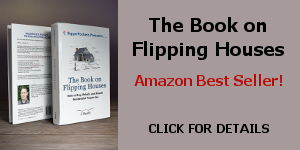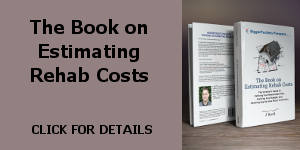In my last post, I discussed the idea of putting together a business around buying distressed properties, rehabbing them, renting them, and then selling them for a profit when the market improves. To clarify what the business model might look like for this type of endeavor, I want to outline a hypothetical (but very realistic) scenario for a rehab and rent project. While every real estate transaction is unique, this one fits the profile for a project that could easily be available in our area.
Hypothetical Rehab & Rent Scenario
Our buyer looks at a bank owned (i.e, foreclosed) property in the west suburbs of Atlanta, GA, listed for sale at $82,000. Based on local comps, the ARV (“After Repair Value,” which is the expected value after renovation) of the property is $120,000. Given the current real estate market, our buyer believes that she’s unlikely to sell the property at that price in the next 12 months. Our buyer runs an initial analysis to determine whether the property will cash flow as a rental, and under what circumstances.
Our buyer makes an initial offer of $65,000 for the property, and after multiple rounds of negotiation, a purchase price of $75,000 (including closing costs) is agreed upon. Our buyer purchases the property in cash for $75,000. (Given the state of the foreclosure market, this is a very realistic scenario)
Over the next 45 days, our buyer hires sub-contractors to perform rehab and remodeling work. The total remodeling costs plus carrying costs for the 45 days is $15,000, with that money coming directly from our buyer’s cash reserves. The finished house has required a total investment of $90,000, and after rehab, the house will appraise for $120,000, creating $30,000 in total equity.
In the following 90 days, our buyer works with traditional property lenders to refinance the property, ensuring that the resulting loan balance (and mortgage payments) are low enough to allow the property to sufficiently cash flow (in other words, the loan will be small enough that our buyer will be able to rent it out and make a profit each month).
Based on the following assumptions (also completely realistic for this area):
- Market Rents: $1050
- Average Vacancy Rate: 8.3% (one month per year)
- Expenses: 40% of Net Income
- Loan: 6.5% Fixed for 30 Years
Our buyer decides to refinance the property for $80,000.
Our buyer’s initial out-of-pocket costs were $90,000, and the new loan allows our buyer to recoup $80,000 of that back. With 2.5% closing costs on the refinance, our buyer’s total out-of-pocket expenses after refinance are $12,000.
Given the assumed income and expenses data above (again, perfectly realistic in this area), our buyer can expect the following ROI in Year 1:
- Cash Flow: $862
- Equity Accrual from Loan Payments: $894
- Cash-on-Cash Return: 7.43%
- Total Return: 15.14% (not including tax benefits, which are investor dependent)
But, let’s not forget the fact that our buyer generated instant equity from her rehab work. The ARV of the house is $120,000, and after refinance, the amount owed is $80,000. So, our buyer has created an additional $40,000 in equity/profit on this house.
This takes our total return for Year 1 to 348%! **
Now, you might say, “But our buyer can’t sell the property in Year 1, so those profits are just on paper.” Very true. But, given the historic cycles of the real estate market, it’s very likely that our buyer will be able to sell the property within 5 years.
To figure out our 5 year return on this property, let’s make the following assumptions:
- 2% annual increase in rental revenues
- 2% annual increase in expenses
- 2.5% annual increase in property values
- 6% sales commission on sale of the property
Given these parameters, if the house is sold after Year 5, the total income/expense on the property will consist of: Initial Investment (-$12,000), Sale Price of the Property ($135,769), Loan Payoff Amount (-$74,888), Accrued Cash Flow ($6,431) and Sales Commission ($7,200). Total net income on the property at sale will be $48,112.
The resulting ROI over 5 years is just over 400%. This is a return of over 80% per year, and an annualized compounded return of over 32%!
Try getting that from the stock market…
** Total Return = ($40,000 in equity + $862 in Cash Flow + $894 in loan equity) / ($12,000 investment)




This sounds like a great deal, especially if the investor can sell within a couple of years. In order to get the bank loan to purchase the property, wouldn’t the investor have to put at least 20% down? Won’t that 20% be tied up in the property until it sells?
In the example, the buyer is purchasing the property cash, not getting a loan to purchase it; so really the buyer has to put 100% down ($75,000) + rehab & holding costs ($15,000) so the buyer is actually putting down 120%! Assuming the buyer has the money to do this, I think the point is that he/she will be getting 89% of the money back by refinancing ($80,000 of the initial $90,000). My understanding is that the most banks will refinance up to 80% of the value of the property; that being said, in this example a refinance of $80,000 is 67% of the $120,000 that the house is worth, making it very possible to do but it would tie up $90,000 until rehab is complete and you are ready to refinance. Please correct me if I am wrong… thanks!!
Brandon –
Yes, this is exactly the intent of the scenario. Of course, many buyers wouldn’t have the cash to purchase the property outright, and would likely need to figure out a financing strategy that worked for them, but because everyone will be in a different situation, I didn’t want to assume any particular financing strategy.
Hi Scott,
I got the same result of yours after draft the calculation below.
1) Cash Flow:
netcome(after Tax): $1050 * (1-8.3%)*(1-40%) = $578,
mortgage: $506
1st year net Cash Flow: ($578-$506)*12= $864
2) Equity Accrual from Loan Payments (end of 1st year):
($80000-$79106)= $894
3) Cash-on-Cash Return: 7.43% = $864 / $12000
I am interested in this because I am in the middle of a bid war of my 1st REO property listed at $39.9K. I offered 52k. It is a legal 2-unit multifamily house with the third unit in the attic. The ARV is about 100K to 120K for the normal comps ( very close to your assumption). I was hesitating whether I should go forward if the seller accept my offer because I am afraid of running out of cash. Now that if I can take the cash out after the rehab by financing, I think it probably is not a bad one for me after I hold it for 5 years.
You calculation is very helpful on my ongoing bidding. I greatly appreciate it.
BTW, I think your assumption of “Expenses: 40% of Net Income ” includes the Property Tax, am I right? what is the Property TAX in your assumption? The one I am bidding is $3233.
Thanks
Hey Jack –
Yes, the 40% expenses includes the property taxes. In general, I like to assume that expenses (including vacancy) will come to between 45-50% of the gross rental income, with the remaining 50-55% left to cover the mortgage and profit.
Check out the 50% Rule: http://www.123flip.com/education/the-50-rule
Thanks Scott! I just got the news from the realtor that I won the bid. I am so excited.
HI Scott,
Is it a good idea to buy condo’s right now and flip them? In particular a condo conversion by Chastain Park in Buckhead area of ATL for 40k and then flip it for 75k.
Thanks.
Jeff –
Condos are a difficult to flip these days, for a number of reasons:
1. Many buyers prefer houses, and in today’s down real estate market, you can get a single family home for the same price as a condo in many areas;
2. Investors aren’t buying condos these days before of the association rules that limit the number of units in any particular building that can be rented at once. Because so many owners need to rent these days, investors are scared that if they buy a condo unit, they won’t be allowed to rent it;
3. Condo association fees tend to be very high, and can make owning a condo disproportionately expensive compared to a single family home.
All that said, if the association fees aren’t ridiculous, if you are confident you can find a buyer at your targeted price, and if you have a backup exit plan in the case the flip doesn’t work out, it can’t hurt to try. Plus, the Buckhead area is holding its value pretty well, so if you’re going to flip a condo, that’s as good a place as any to try.
Just double check that the numbers work before you jump in…
Could you explain how you calculated your accrued cash flow? Wouldn’t it be 5 years of cash flow plus 5 years of equity payments into the loan?
Also do you factor in any benefits from depreciation as a return on the investment?
Thanks for all your great work.
Awesome article. Why is it awesome? Because this is the exact model I am following, and the numbers are almost literally exact. (but my mortgage is only a 30 @ 4.0%) I am currently living there, but renting out one room to a friend, and intend to finish basement and rent, then when I find the next property in two years that I can owner occupy, rent it out fully. (thats the ideal plan anyway). I got super lucky, got a HUD home with an owner occupy offer, with an unfinished basement and attic, and all the major mechanicals/roof less than 8 years old. I am currently rehabbing while we live there. My only problem is deciding to flip within the next 2 years either on a 1031, hold 2 years and sell, or holding long term for passive cash flow…. Also unsure if I could refi (with new renovations considered) and pull out some equity, or if I even should. I believe my expenses to be low enough now, where it would always cash flow in any rental market, but if I were to refi for a higher loan amount thay may change in a very down rental market (say in 5 years all the builders are going stupid crazy throwing up homes again). Lastly, with this low inventory condition lately, some houses are selling for normal prices around here. The rehabs are still reasonable 49-80k , but the turn key 3/2 homes in the downtown areas are going for 120-140k. Decisions, decisions.
Shane –
It sounds like you have GOOD problems, which is always a good thing!
With lots of good options, I can’t tell you which way to go, but will suggest that you constantly evaluate all your options and whichever one jumps out at you, go with it.